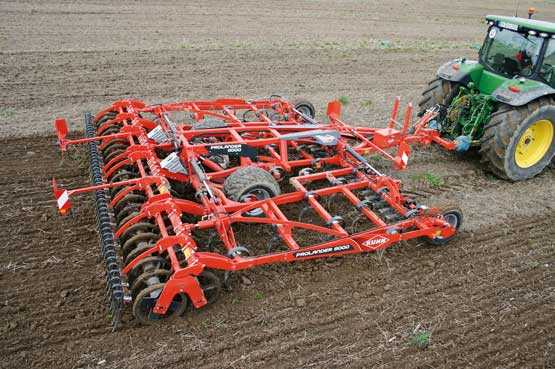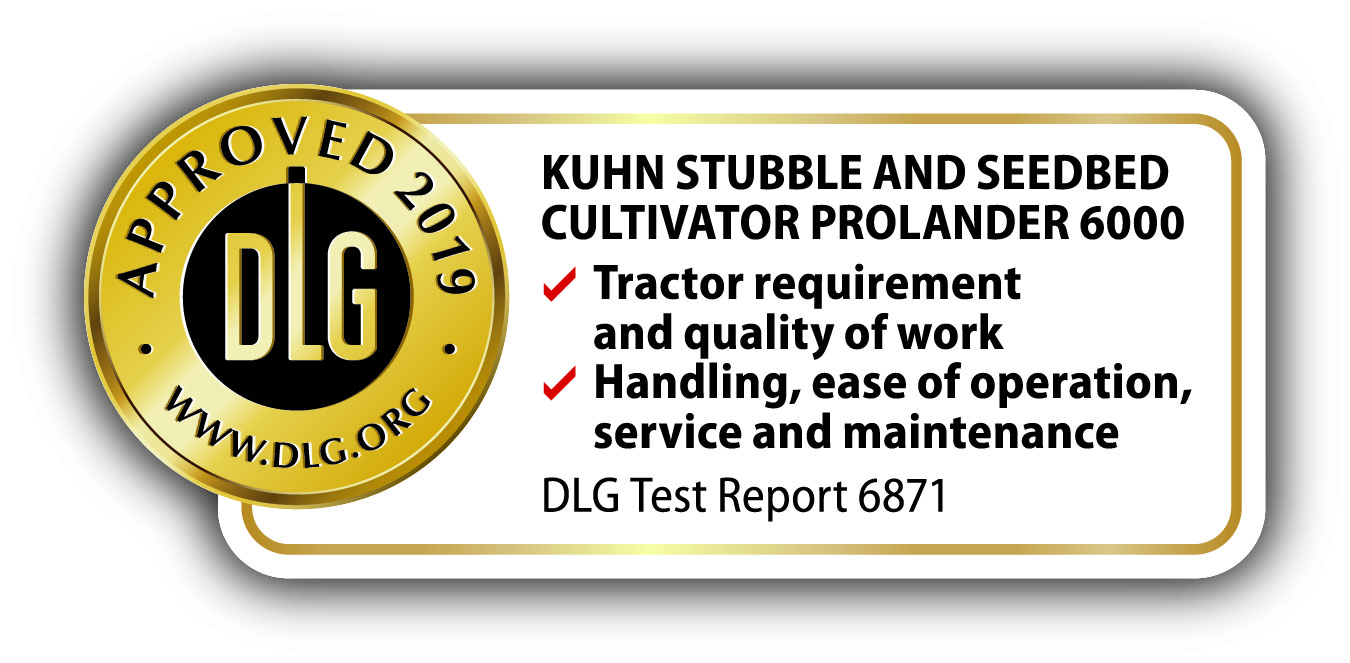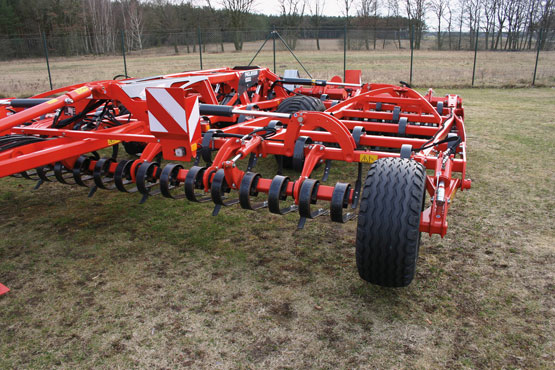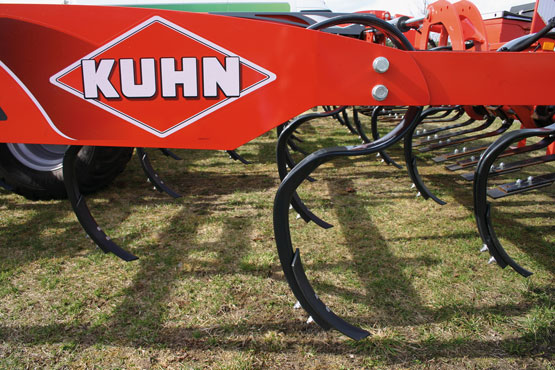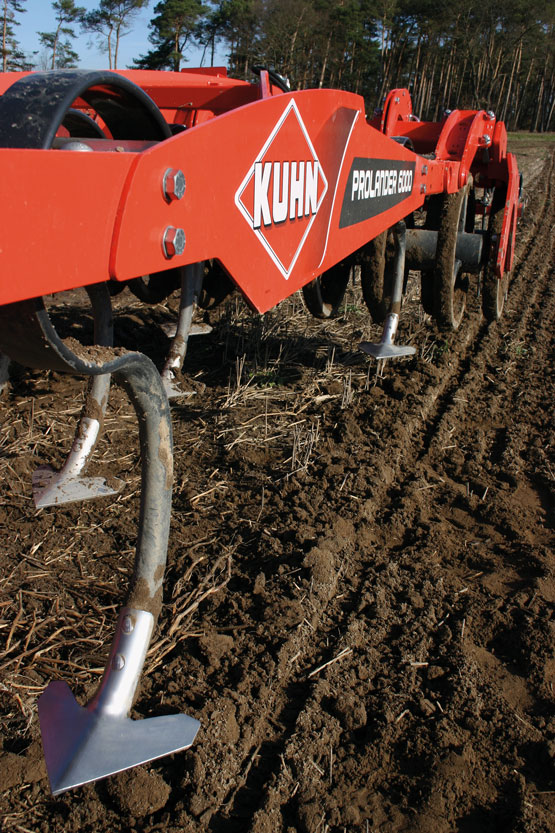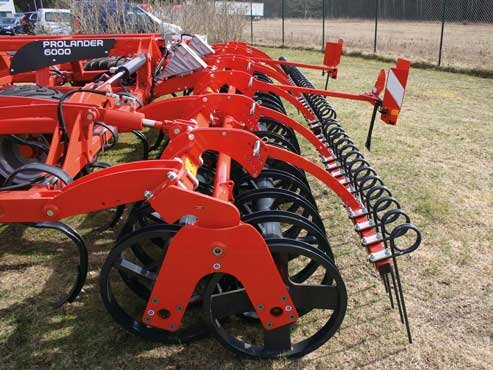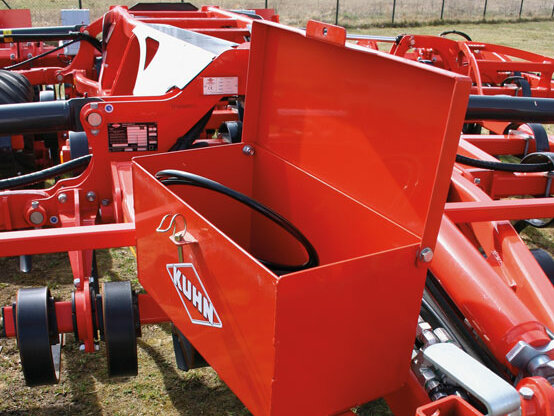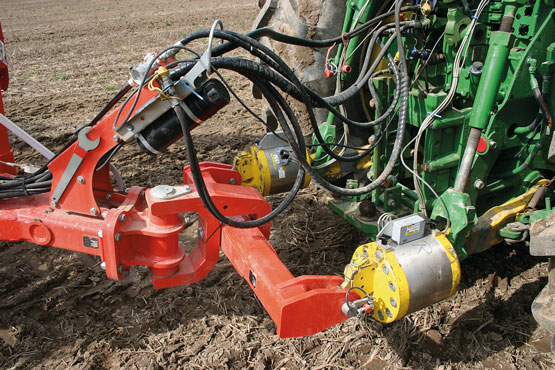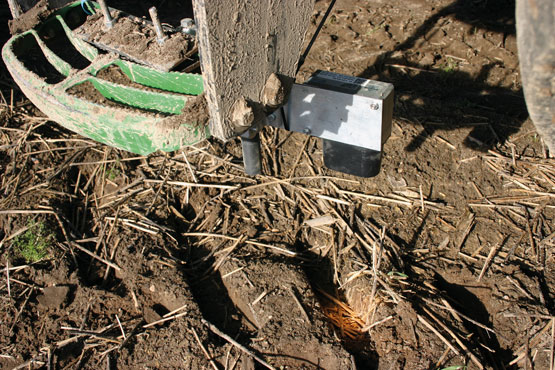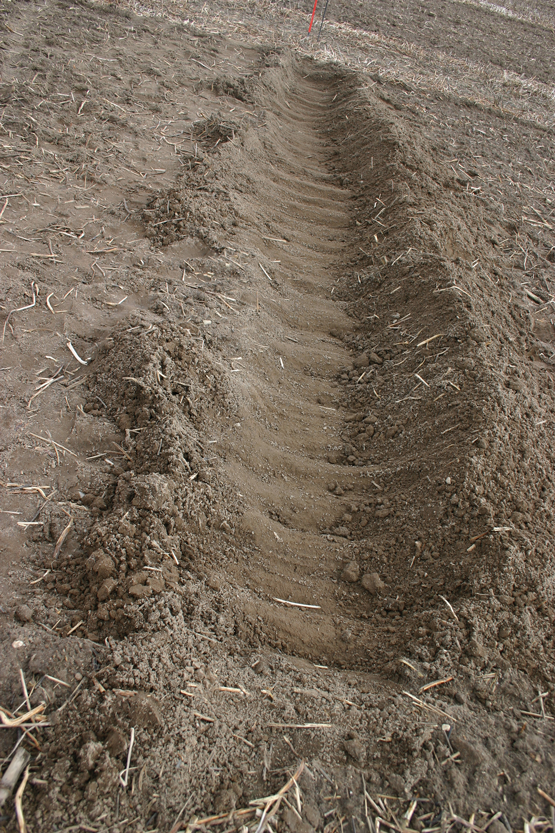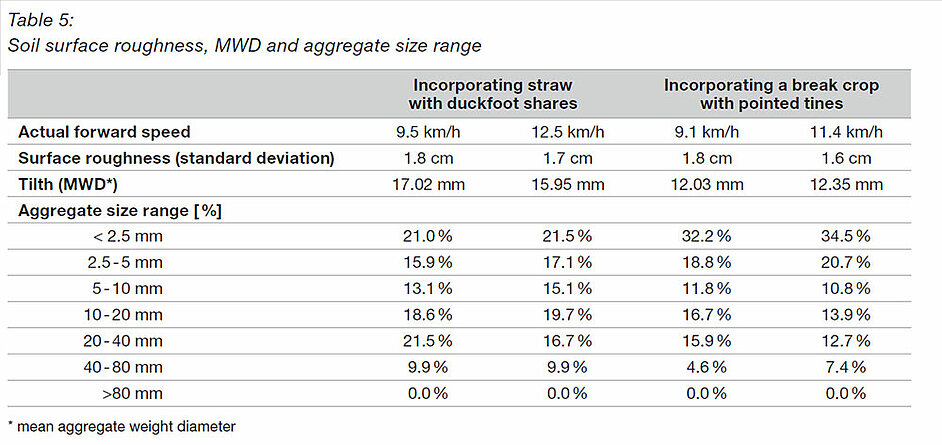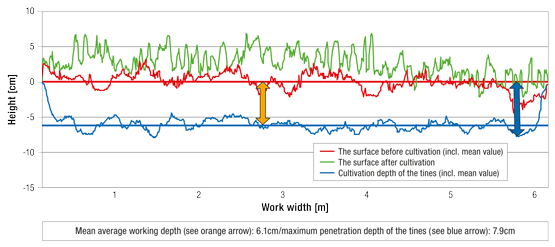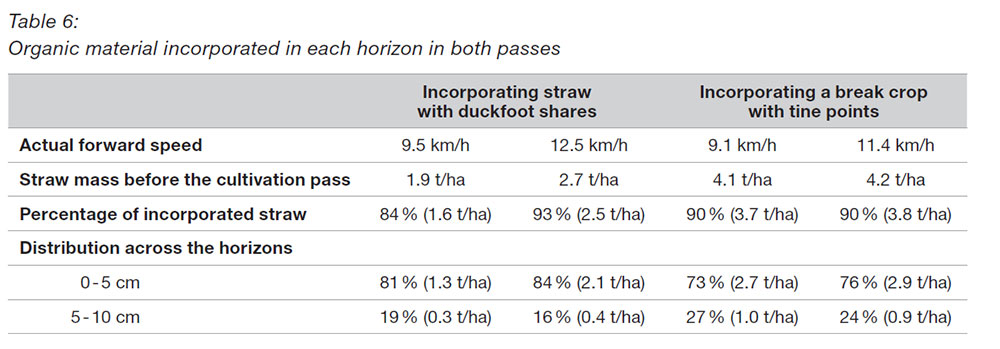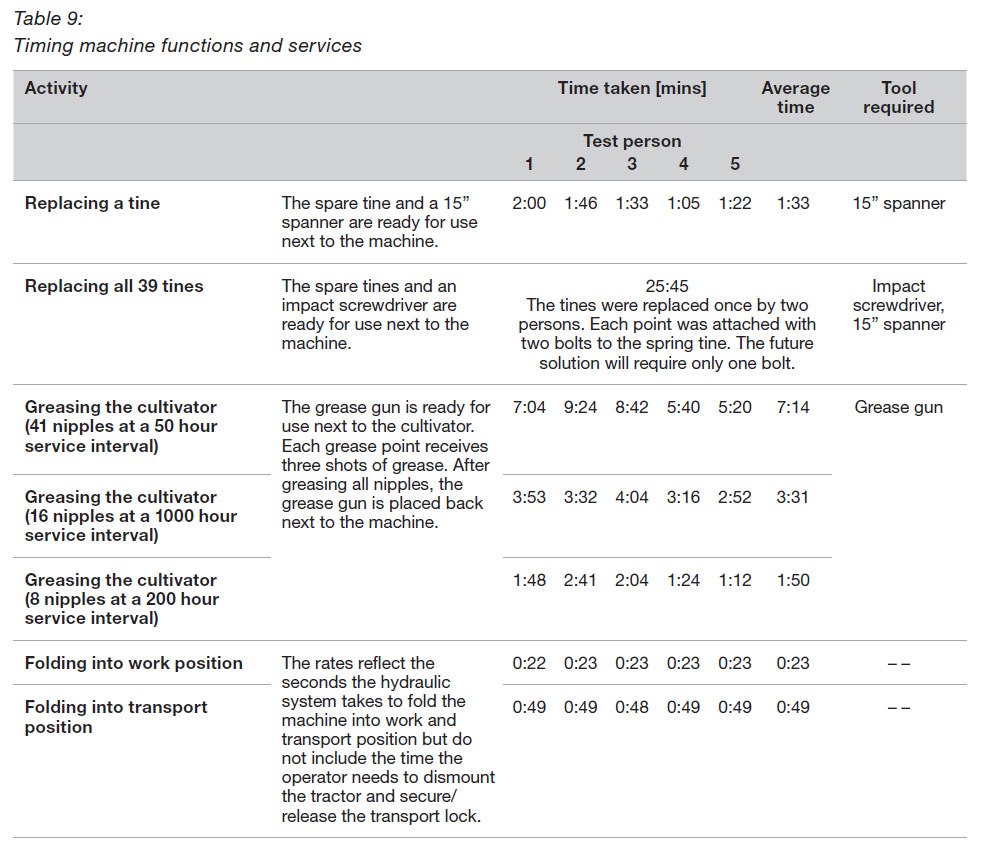Kuhn Stubble and seedbed cultivator KUHN Prolander 6000
DLG-APPROVED "Tractor requirement and quality of work Handling, ease of operation, service and maintenance"
The certification mark
A test mark „DLG-APPROVED for individual criteria“ is awarded for agricultural products which have successfully fulfilled a scope-reduced usability testing conducted by DLG according to independent and recognised evaluation criteria. The test is intended to highlight particular innovations and key criteria of the test object. The test may contain criteria from the DLG test scope for overall tests, or focus on other value-determining characteristics and properties of the test subject. The minimum requirements, test conditions and procedures as well as the evaluation bases of the test results will be specified in consultation with an expert group of DLG. They correspond to the recognised rules of technology, as well as scientific and agricultural knowledge and requirements. The successful testing is concluded with the publication of a test report, as well as the awarding of the test mark which is valid for five years from the date of awarding.
The Kuhn Prolander 6000 stubble and seedbed cultivator (6 m working width) was subjected to two DLG tests – the “Tractor requirement and quality of work” test and the test on “Handling, ease of operation, service and maintenance”. The relevant measurements were carried out in a mainly flat field of sandy loam soil where a crop of rye had been harvested the year before. In this field, the cultivator was used to incorporate stubble and a break crop.
The test examines the cultivator to the test parameters set out in the DLG test framework for tillage
equipment. These include the following:
- tractor requirement
- actual forward speed and nominal ha/h performance
- maximum penetration, average working depth and tillage depth of the tines
- profile of the soil surface before and after the cultivation pass
- tilling effect (distribution of the soil aggregates)
- thickness of the straw mat and effectiveness of incorporation
- visual assessment of the quality of work by farming experts
- overall machine handling, ease of operation, service and maintenance
The field conditions prevailing during the test runs were documented and comprised the stubble heights, the thickness of the straw mat, the soil moisture and the weather conditions. No other criteria have been examined in this test.
Assessment in brief
The performance of the Kuhn Prolander 6000 stubble and seedbed cultivator in all criteria specified by the DLG test framework was impressive. Based on the good test results, the cultivator is awarded the DLG APPROVED quality mark in the test modules “Tractor requirement and quality of work” and “Handling, ease of operation, service and maintenance”. The tractor input during stubble incorporation with duckfoot shares was 103 hp (at a work rate of 9.5 km/h) and 177 hp (at a work rate of 12.5 km/h). The tractor input during incorporation of a frozen break crop using pointed tines was 119 hp (at 9.1 km/h) and 189 hp (at 11.4 km/h).
Table 1: Assessment in brief
| Quality of work as assessed by farming experts | Averaged score | |
|---|---|---|
| Distribution of crop residues on the surface after cultivation | Straw incorporation | good |
| Break crop incorporation | very good | |
| Levelling effect by the cultivator | Straw incorporation | satisfactory * |
| Break crop incorporation | good | |
| Uniform depth control | Straw incorporation | good |
| Break crop incorporation | good | |
| Aggregate sizes and tilth | Straw incorporation | good |
| Break crop incorporation | very good | |
| Reconsolidation | Straw incorporation | good |
| Break crop incorporation | good | |
| General quality of work | Straw incorporation | good |
| Break crop incorporation | good |
The Product
Description and technical data
According to the manufacturer, the Kuhn Prolander 6000 stubble and seedbed cultivator is suitable for the incorporation of straw and break crops and seedbed preparation. The cultivator is available in 6m and 7.5m work widths and a new foldable mounted range in 4, 5 and 6 metres. The working width of the test unit was 6 m. The machine was semi-mounted to the tractor with a linkage drawbar (cat III). The machine can also be attached using a K80 hitch ball or hitch ring, depending on specification.
The first toolbar on the Kuhn Prolander 6000 stubble and seedbed cultivator is a levelling bar which is adjusted hydraulically from the cab to alter its intensity of work. The 22 elements on this leading bar are arranged between the two depth wheels. Each of these levelling elements is 10 cm wide and spaced at 12 cm from its neighbouring element(s) (figure 2).
The spacing of cuts is 150 mm from 39 tines arranged in a 5,850 mm wide field measured from the left to the right tine. Each point on the test candidate was attached with two bolts to a pig tail spring tine. In the future the tines will be attached with only one bolt to speed up point changes, says the manufacturer. The shares or spring tines are arranged on five beams. The test machine was fitted with 55 mm pointed tines or 205 mm wide duckfoot shares (figures 3 and 4).
Depth control on the Prolander 6000 is provided by two leading depth wheels and the trailing press at the rear. The working depth is adjusted hydraulically from the cab via double-acting rams. An easy to read scale on the right depth wheel helps operators to find previous depth setting.
The trailing press on the test machine was a double roller with channel rings that was split into three sections (figure 5). This roller measures 600 mm in diameter. The first roller consists of 23 rings while the second roller consists of 24 rings. The entire press combination is mounted in twelve ball bearings, each with a separate grease nipple that is greased every 50 hours.
The roller is followed by a levelling tine bar that is split into four sections. Its harrowing intensity is adjusted manually by refitting eight pins.
Headland turns are managed by lifting the machine via the running gear.
Changeovers from work to transport position are made by folding the wings hydraulically to the vertical. In transport position, the operator has to secure the hydraulic rams manually by closing two ball valves. This is to prevent accidental unfolding during road travel.
Lights, air brake, a storage box for tools or spare points (figure 6) and warning panels are standard specification on the Prolander 6000.
The eight hoses of the four hydraulic circuits (folding, lifting/lowering the running gear, depth control, adjustment of the levelling bar) can be stored in hose holders after removal.
Table 2: Kuhn Prolander 6000 stubble and seedbed cultivator – specifications (manufacturer information)
| Technical Data | |
|---|---|
| Working width | 6.0 m |
| Underbeam clearance | 600 mm |
| No. of tines | 39 |
| Spacing of cuts | 150 mm |
| No. of toolbars | 5 |
| Interbar distance | 60 cm to 80 cm |
| Maximum work depth | 16 cm |
| Weight incl. trailing press | 5,616 kg |
The Method
The DLG test “Tractor requirement and quality of work” examines the performance of tillage equipment in the field by applying test criteria that are specified by the DLG test framework. The test comprises measurements that are carried out in suitable test fields and at typical forward speeds and working depths.
The conditions prevailing at the time of the test are documented and include the topography, the stubble heights, the straw residues on the surface, the soil moisture and the weather at the time of the test.
In each DLG test, the implement to be tested is set up on the site so the settings suit the specific conditions. These settings are determined by carrying out preliminary trial runs in the test field. These runs do not form part of the actual test. Immediately before and during the actual test runs the test conditions are documented by taking soil samples to measure the soil moisture and by measuring the stubble height. Also, the type of soil and disposition of the field is documented. The implement’s draft requirement is measured using the DLG-owned equipment modules. Ground speeds and distances travelled are measured with the Correvit L400 system from KISTLER MESSTECHNIK (figures 7 and 8). In addition, fuel consumption can be measured using the mobile DLG fuel metering equipment.
The machine’s nominal ha/h performance is computed using forward speed and working width data, but without taking into account potential overlaps and turn around times.
Zur Bestimmung der Oberflächenprofile vor und nach der Bearbeitung sowie der Eingriffstiefen der Werkzeuge (Schare) und der mittleren Arbeitstiefe wird ein Lasersensor eingesetzt. Die Oberflächen werden quer zur Fahrtrichtung mit dem Lasersensor berührungslos abgetastet und aus den Messwerten wird dann ein Höhenprofil erstellt. Für das Höhenprofil der bearbeiteten Bodenoberfläche wird aus den einzelnen Messwerten die Standardabweichung (SD) errechnet, um die Ebenheit der Fläche zu beschreiben. Je niedriger die errechnete Standardabweichung ist, desto ebener ist die bearbeitete Bodenoberfläche. Für das Einmessen des Bearbeitungshorizontes wird dieser freigelegt (Bild 9). Aus den Messwerten des Bearbeitungsprofils der Werkzeuge (Schare) wird dann die maximale Eingriffstiefe ermittelt und die mittlere Arbeitstiefe berechnet.
Zur Darstellung der Krümelwirkung des Bodenbearbeitungsgerätes wird die Aggregatgrößenverteilung in der Bearbeitungsschicht gemessen und dargestellt. Hierfür werden vorsichtig und zerstörungsfrei Bodenproben aus der bearbeiteten Bodenschicht entnommen und anschließend bis zur Gewichtskonstanz luftgetrocknet. Die so getrockneten Bodenproben werden dann mittels Siebanalyse fraktioniert und aus den Anteilen in den verschiedenen Bodenfraktionen der gewogene mittlere Durchmesser (GMD) berechnet. Je kleiner der GMD, desto größer ist der Anteil an kleineren Bodenaggregaten.
Vor und nach der Bodenbearbeitung wird die Strohauflage ermittelt. Hierzu wird das Stroh an mehreren repräsentativen Stellen des Versuchsschlages auf jeweils einer Fläche von einem Quadratmeter vollständig aufgenommen, anschließend luftgetrocknet und gewogen. Aus der Differenz der beiden Ergebnisse wird die Strohmenge errechnet, die durch die Bearbeitung in den Boden eingemischt wurde.
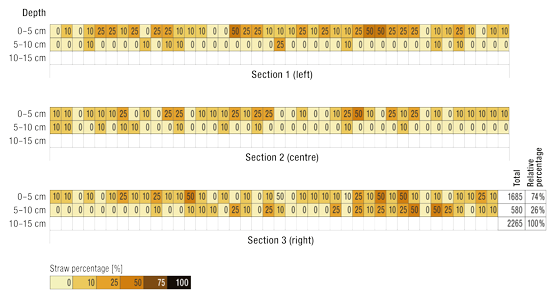
The surfaces before and after the cultivation pass, but also the penetration depths of the tines and their mean work depth are measured with the help of a laser sensor. This non-contact sensor scans the surface of the field across the direction of travel.
The data collected are used to compute the height profile. The height profile of the cultivated surface is determined by computing the standard deviation (SD) from the individual scans. This describes the levelness of the surface. The smaller the standard deviation, the more even the cultivated surface. To measure the cultivated horizon, the testers clear out a trench to the depth of cultivation (figure 9).
The actual depth of cultivation by the tines is used to determine the maximum penetration depth and mean working depth. The clod crushing effect of the cultivator is illustrated by measuring and plotting on a graph the distribution of the individual aggregate sizes in the cultivated layer. This is done by taking soil samples from the cultivated layer without destroying the aggregates. Then the samples are air dried until the weight remains unchanged. Next, these air dried samples are screen fractioned and the mean weight diameter (MWD) is computed from the samples in the individual fractions. The smaller the MWD the higher is the percentage of small soil aggregates.
The thickness of the straw layer is determined before and after the cultivation pass. This is done by removing all straw residues from several representative 1 m² plots in the test field and weighing the collected mass. The straw is then air dried and weighed again. The difference between the two results is used to compute the straw quantity that was incorporated by the cultivator.
The distribution of incorporated straw in the individual layers is measured with the help of the grid method by VOßHENRICH (2003). This method clears out a trench across the full working width and to a depth of 20 cm, making sure a smooth wall face is cut. The soil is the the sampled in 5 cm by 5 cm grid squares and the straw found in each square is sampled and classified. The findings are illustrated in a graph (fig. 10). The straw is classified by using different shades of orange. A darker shade indicates a higher amount of straw for that particular grid.
For a better overview, the graph is split into three sections (left section, central section, right section). The sums of the numerical values per soil horizon (straw distribution) are also entered in the graph (bottom right). These sums are used to compute the relative percentage of incorporated straw. The graph below is one example of the DLG test results from the Kuhn Prolander 6000 seedbed cultivator (break crop incorporation with tine points set to 13 cm working depth and 9.1 km/h forward speed).
Furthermore, the quality of work was assessed.
This was examined in situ by five farming experts. The assessment was made by applying a five point grading system: very good (1), good (2), satisfactory (3), sufficient (4), not sufficient (5).
Handling and operation, service and maintenance
Ease of handling is assessed using the following criteria:
- Setting the working depth
- Adjusting the levelling bar
- Storing the hydraulic lines
- Fitting/Removing the lighting unit
Each aspect is assessed based on the DLG assessment scheme. In addition, the test also involves timing service and maintenance jobs that are carried out by the same farming experts. These tasks include the following:
- Changing tines
- Greasing nipples that are due at specific intervals
- Changing from transport to work position and vice versa
Detailed account of test results

The test
The test took place in Saxony-Anhalt, Germany, in April 2018. The field was a harvested field of rye. The mostly homogeneous test plot is classified as ‘sandy loam’ at the numerical value 33. The weather during the test was sunny with some wind and temperatures ranging between 14° C and 20° C. The soil moisture during the test ranged between 3.9 % and 11.9 %. The straw on the straw incorporation plot was cleared after the rye was harvested in August 2017. The straw on the break crop incorporation plot was also cleared in August 2017. A mix of Phacelia, clover, oilseed radish was then drilled directly into the stubble. The DLG test took place in April 2018 and consisted of incorporating the stubble with duckfoot shares (8 cm working depth) and the frozen break crops with pointed tines (13 cm working depth).
The length on the stubble in the straw incorporation plot was 18 cm (shortest length: 10 cm, maximum length: 30 cm, standard deviation: 4.9 cm). The mean thickness of the straw mat consisting of chaff and stubble prior to cultivation was 1.9 t/ha and 2.7 t/ha. The mean volume of organic material on the break crop plot was 4.1 t/ha and 4.2 t/ha. Table 3 shows the most relevant field conditions and the two test versions.
The tractor was a John Deere 8285R (282 hp rated output, 310 hp maximum output at 1,900 rpm).

Forward speed, working depth, draft requirements and ha/h performance
Table 4 below shows the test results in terms of actual forward speed and working depth, the resulting draft requirement and the computed nominal acreage.
All target depths were reached in the DLG test. In stubble incorporation with duckfoot shares, the draft requirement increased from 103 hp to 177 hp and in break crop incorporation from 119 hp to 189 hp when forward speed increased. Working at 9.1 km/h, the stubble and seedbed cultivator with a 6m work width achieved nominal work rates of about 5.5 ha/h. Working at 12.5 km/h the nominal work rate was 7.5 ha/h.
Soil surface roughness, MWD and aggregate size range
Soil surface roughness is expressed by the standard deviation (SD) and the level of tilth, which is in turn expressed by the mean weight diameter (MWD) of the soil aggregates after the cultivation pass. The cultivator achieved a comparable levelness in both test versions. The same applies to the distribution of soil aggregates in both test versions using the same tines. The duckfoot shares produced a mean aggregate size (MWD) of 17.02 mm and 15.95 mm. The mean aggregate size produced by pointed tines was 12.03 mm and 12.35 mm. In our light test soil, it took only a slow forward speed to produce a high percentage of tine tilth. The pointed tines produced a higher percentage of tilth than the duckfoot shares (table 5).
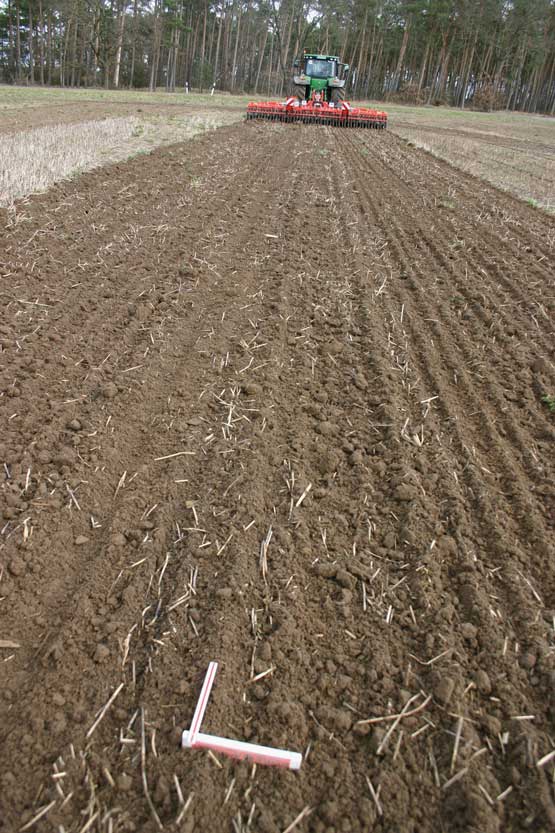
(Forward speed: 9.5 km/h)
The graph in figure 11 shows the soil surface data before and after the shallow straw incorporation pass using duckfoot shares at a forward speed of 9.5 km/h. The red curve shows the soil surfaces before the cultivation pass (red), the green curve indicates the profile after cultivation and the blue curve the cleared trench that reflects the horizon that was cultivated by the tines. The blue arrow in table 11 indicates the maximum penetration depth (= working depth). This is 7.9 cm in the example shown. The computed mean working depth is 6.1 cm (orange arrow). The standard deviation (SD) measures the roughness of the soil surface after the cultivating pass and is 1.8 cm in this example.
Straw mat and straw incorporation
One straw incorporation plot was cultivated at a forward speed of 9.5 km/h. The amount of residues (straw including stubble and chaff) was 1.9 t/ha before the cultivation pass. The duckfoot shares mixed 84 % of the straw (1.6 t/ha) into the soil.
The other straw incorporation plot was cultivated at a forward speed of 12.5 km/h. Here, the amount of residue was 2.7 t/ha before the cultivation pass. The cultivator mixed in 93 % of the residues (2.5 t/ha).
This percentage increased when the forward speed increased in this test version. 81 % and 84 % of the incorporated straw was mixed into the top layer (0-5 cm depth) and 19 % and 16 % was mixed into the next deeper layer (5-10 cm depth).
The distribution of the straw across layers was not affected by the forward speed.
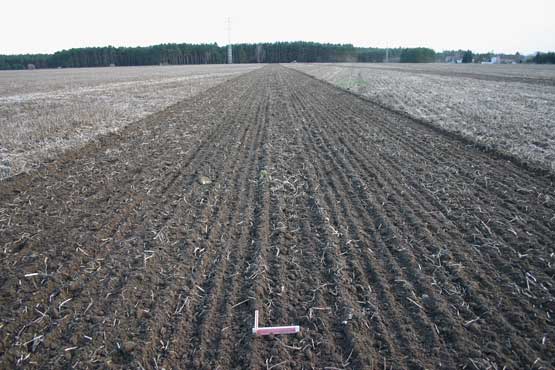
(Forward speed: 11.4 km/h)
Figure 12 shows one of the passes where the straw was incorporated with duckfoot shares (9.5 km/h forward speed).
When cultivating break crops with tine points at a forward speed of 9.1 km/h, the cultivator mixed in 90 % of the residues (3.7 t/ha). After forward speed increased to 11.4 km/h, the percentage of incorporated material remained unchanged at 90 % (3.8 t/ha). The distribution of the material across the various horizons was not affected by changing the forward speed. About 75 % was mixed into the top layer (0-5 cm) and about 25 % was mixed into the next layer (5-10 cm) (see table 6). Figure 13 (see page 12) shows a plot after the second cultivation pass (at 11.4 km/h).
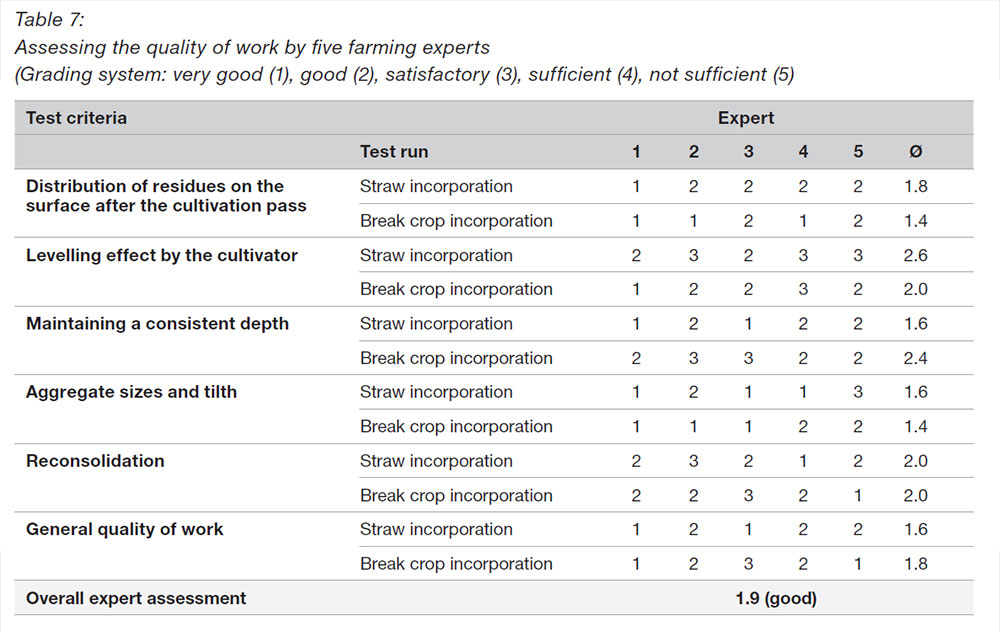
Working quality assesment by five farming experts
The quality of work was assessed by five farming experts. The results of this part of the test are shown in table 7.
Handling, ease of operation, service and maintenance
Assessment of machine handling
The working depth is set without tools using hydraulic rams controlled from the cab. A scale on the front right depth wheel helps find a preset depth quickly (++).
The levelling bar is also adjusted via hydraulic rams and without tools. These hydraulic cylinders, too, are controlled from the cab. There is no scale that helps retrieve a previous setting (+).
All hydraulic couplers on the test machine were marked by colour coded caps. The same colour code is repeated by decals on the holder, helping operators to match hoses and couplers quickly. After the cultivator is removed from the tractor, the hoses are stored in their specific holders. There is no drip container to collect leaking oil. The oil hose holder is graded as good (+) to the DLG assessment scheme.
The cultivator has a permanent lighting system which is not removed from the machine during field work. There is no dust/water-proof holder to store the electric connector after its removal from the tractor (+).
Table 8 (page 14) gives an overview of the results of this test module.
Time spent on service and maintenance
The DLG test also included the timing of servicing and maintenance. All results of this test module are grouped in table 9 (page 14).
Table 8: Assessment of handling
| Test criteria | DLG score * | Comments |
| Setting the working depth | very good | The operator can adjust the work depth from the tractor on the move. |
| Setting up the levelling bar | good | The operator can adjust the levelling bar from the tractor on the move. |
| Holder for hydraulic lines | good | The oil hoses are colour coded and stored tidily in a holder. |
| Attachment/removal of the lighting system | good | The lighting system is permanently installed, but the electric connector is not protected from dust and moisture. |
Summary
The DLG test for the Kuhn Prolander 6000 stubble and seedbed cultivator consisted of the test modules “Tractor requirement and quality of work” and “Handling, ease of operation, service and maintenance”. The cultivator is suitable for the shallow incorporation of stubble and mixing in a break crop. The test runs were smooth and no blockages were observed.
The tractor input during stubble incorporation with duckfoot tines was 103 hp (at 9.5 km/h) and 177 hp
(at 12.5 km/h). The tractor input during incorporation of a break crop using pointed tines was 119 hp (at 9.1 km/h) and 189 hp (at 11.4 km/h).
The quality of work was assessed by expert farmers. These assessed the quality of work as very good, good and satisfactory in all criteria. The overall score across all test criteria was 1.9 (good).
Machine handling received ‘very good’ and ‘good’ marks.
Based on these results, the Kuhn Prolander 6000 stubble and seedbed cultivator is awarded the DLG APPROVED quality mark 2018 in the test modules “Tractor requirement and quality of work” and “Handling, ease of operation, service and maintenance”.
Contact
DLG TestService GmbH - Groß-Umstadt location • Max-Eyth-Weg 1 64823 Groß-Umstadt Germany • Tel.: +49(0)69 24 788-611 • tech@DLG.org

